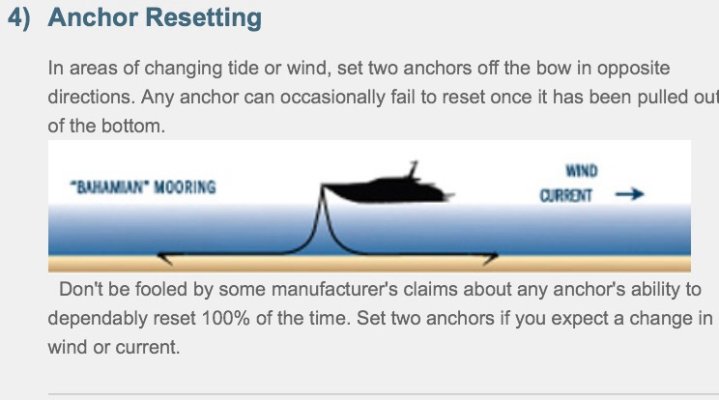Just my opinion Brian, but what you did with these tests was as close to a scientific study of anchor performance as I have seen. Scientific studies rarely address universal conditions, but rather focus on one or two things to try to get to a better understanding. In personal experience, I've collaborated on scientific studies on the effect of periodontal disease risk on tooth loss. In these studies we didn't pay attention to the impact of perio on diabetes treatment, or prematurity, or anything else - just how many teeth were lost. Eliminating variables is usually important for study design and validity, and what you did was focus on the performance of anchors in one commonly encountered sea bed. Nothing more, and nothing less.
IMO, complaints that because your study didn't address anchor performance in other conditions is way off base.
What an objective person should be able to conclude from this study is that some anchors suck in soft mud (pun intended), and others perform well with the Fortress performing the best. Seems valid to me.
Thanks Delfin. Your comments on anchoring threads are oftentimes humorous and insightful. Much appreciated!
It would be useful if when anchors are tested some indication is given of what the seabed is actually like, thin mud lacks sufficient information. I'm not sure how you do this but knowing that the tests in Chesapeake were conducted in a seabed like fresh yogurt might be more useful than thin mud. It would also be useful if regions with similar seabeds were quoted, so do areas in San Francisco Bay, Thames estuary have similar muds of similar consistency. Are there hydrographic surveys available that define seabed consistency?
I will check with Bob Taylor and see if he can answer this. I know that he is well familiar with "soil shear strength" figures, and he has stated previously that soft mud is commonly found in bays, harbors, lakes, rivers and some seas throughout the world.
I wonder what the people at fortress would think if one of the other anchor company's paid for a test where they specified a bottom type that would allow their product to set while the fortress would struggle and then try to get as much media coverage as possible. Is that still unbiased independent testing or is it a form of product promotion as in advertising? Would they defend that test as science?
A fair question. If another anchor company conducted a similar in-depth test in a bottom where the Fortress would likely struggle, such as in grass, weeds, or rocks, where the two massive flukes are likely to have difficulty penetrating, then we would certainly not cry foul if the results turned out to be disappointing for our product.
The Fortress is a knock off of the Danforth.
Since we almost all have a power windlass why bother with the lightweight copy , when the steel ancient versions work so well?
And remember Mr. Ogg ,(Danforth inventer) never said to anchor with a Danforth, he recommended at least 2 with more being even better.
The reverse pull out problem will be the same for the aluminum copy , why do they not use the inventors sage advice?
During the Sailing Foundation tests (summary below), pulls were conducted from straight line, 90° and 180° angles. The maximum amount of pull was approximately 4,000 lbs, and the 20+ lb FX-37 exceeded that amount in every direction. No other much heavier steel anchor came close.
Their comments afterwards:
The Fortress set so deep that the rode had to be hauled in to 1:1 and significant power applied to rode by the 83,000-pound tug to break it free. It is doubtful that a sailboat would have windlass power to break it out. Perhaps large primary winches or a rising tide might be adequate. However, it is also doubtful that a sailboat could have set the anchor that deep in less than a full hurricane.
On a side note, our late company founder knew Bob Ogg and he was aboard for the 1990 San Francisco Bay soft mud tests that Fortress sponsored, and we have Mr. Ogg on video complimenting Fortress for the fair and unbiased testing of all anchors.
Marin's comments about user testimony kind of applies here, too. I find test data useful, but not the whole and complete universe of useful factoids. OTOH, user testimony has its flaws, too; imagine the guy on our dock who testifies Anchor X sucks... because he throws it overboard, turns off the engine, and opens a beverage, no additional technique involved. IOW, weeding out the wheat from the chaff, so to speak, is also an issue. As with test data.
-Chris
Well said Chris. I have heard many complaints about the performance of anchors over the years, and when you drill down to find the cause, operator error is certainly not uncommon. The fisherman who is trying to set our 4 lb anchor in 100-ft of the nearby ocean, while using 125-ft of rode with 3-ft of chain and in a heavy current immediately comes to mind.
Fortress do recommend this in their "Safe Anchoring Guide".
Absolutely. Our late founder was a lifelong and very adventurous boater, as he once took his boat 1,000 miles up the Amazon River, he crossed the Atlantic several times, and he completed a circumnavigation in his early 70s.
He used to say that once an anchor breaks free from a sea bottom, then it is oftentimes no longer an anchor, it is likely to be a massive ball without any sharp edges in which to re-penetrate the bottom, so for maximum safety, setting two anchors is advisable if a wind or tidal shift is expected.


